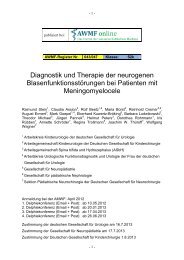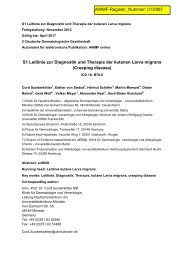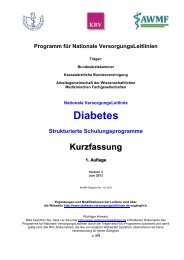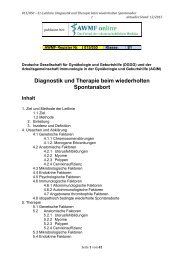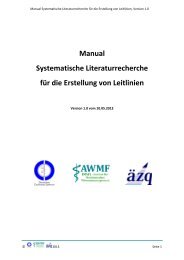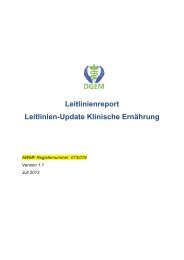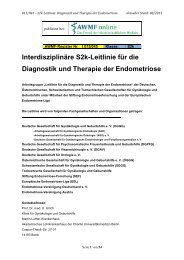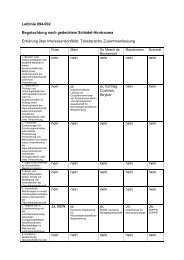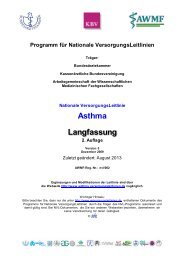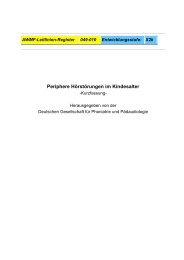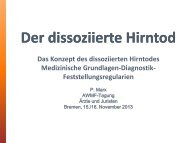AWMF online Synkopen
AWMF online Synkopen
AWMF online Synkopen
Erfolgreiche ePaper selbst erstellen
Machen Sie aus Ihren PDF Publikationen ein blätterbares Flipbook mit unserer einzigartigen Google optimierten e-Paper Software.
Literatur<br />
1. Abe H, Sumiyoshi M, Kohshi K, Nakashima Y. Effects of orthostatic self-training on head-up tilt testing for the prevention of<br />
tilt-induced neurocardiogenic syncope: comparison of pharmacologic therapy. Clin Exp Hypertens 2003;25:191-198.<br />
2. Connolly SJ, Sheldon R, Thorpe KE, et al. Pacemaker therapy for prevention of syncope in patients with recurrent severe<br />
vasovagal syncope: Second Vasovagal Pacemaker Study (VPS II): a randomized trial. JAMA 2003;289:2224-2229.<br />
3. Diehl RR. Vasovagal syncope and Darwinian fitness. Clin Aut Res 2005;15:126-129.<br />
4. Diehl RR, Berlit P. Die quantitative Kipptischuntersuchung mit TCD-Monitoring: Eine reliable Methode zur Diagnose der<br />
neurokardiogenen Synkope (vasovagalen Synkope). Nervenarzt 1995;66: 116-123.<br />
5. Di Gerolamo E, Di Iorio C, Sabatini O, et al. Effects of paroxetine hydrochloride, a selective serotonin reuptake inhibitor, on<br />
refractory vasovagal syncope: a randomized, double-blind, placebo-controlled study. J Am Coll Cardiol 1999;33:1227-1230.<br />
6. Fitzpatrick AP, Banner N, Cheng A, et al. Vasovagal reactions may occur after orthotopic heart transplantation J Am Coll Cardiol<br />
1993;21:1132-1137.<br />
7. Flevari P, Livanis EG, Theodorakis GN, et al. Vasovagal syncope: a prospective, randomized, crossover evaluation of the effect<br />
of propranolol, nadolol and placebo on syncope recurrence and patients' well-beeing. J Am Coll Cardiol 2002;40:499-504.<br />
8. Grubb BP, Kanjwal Y, Kosinski DJ. The postural tachycardia syndrome: a concise guide to diagnosis and management. J<br />
Cardiovasc Electrophysiol 2006;17:108-112.<br />
9. Hainsworth R. Exercise training and orthostatic intolerance. Q J Med 1998;91:715-717.<br />
10. Hilz MJ, Dütsch M. Quantitative studies of autonomic function. Muscle Nerve 2006;33:6-20.<br />
11. Hohnloser SH, Andresen D, Block M, et al. Leitlinien zur Implantation von Defibrillatoren. Z Kardiol 2000;89:126-135.<br />
12. Jacob G, Robertson D, Mosqueda-Garcia R, et al. Hypovolemia in syncope and orthostatic intolerance. Role of the reninangiotensin<br />
system. Am J Med 1997;103:128-133.<br />
13. Kapoor WN. Evaluation and outcome of patients with syncope. Medicine 1990;69:160-175.<br />
14. Kaufmann H, Saadia D, Voustianiouk A. Midodrine in neurally mediated syncope: a double-blind, randomized, crossover study.<br />
Ann Neurol 2002;2:342-345.<br />
15. Kenny R, O'Shea D, Parry S. The Newcastle protocols for head-up tilt table testing in the diagnosis of vasovagal syncope, carotid<br />
sinus hypersensitivity, and related disorders. Heart 2000;3:564-569.<br />
16. Krediet CT, de Bruin IG, Ganzeboom KS, et al. Leg crossing, muscle tensing, squatting, and the crash position are effective<br />
13 16.10.2010 12:31<br />
Die "Leitlinien" der Wissenschaftlichen Medizinischen Fachgesellschaften sind systematisch entwickelte<br />
Hilfen für Ärzte zur Entscheidungsfindung in spezifischen Situationen. Sie beruhen auf aktuellen wissenschaftlichen<br />
Erkenntnissen und in der Praxis bewährten Verfahren und sorgen für mehr Sicherheit in der Medizin, sollten aber auch<br />
ökonomische Aspekte berücksichtigen. Die "Leitlinien" sind für Ärzte rechtlich nicht bindend und haben daher weder<br />
haftungsbegründende noch haftungsbefreiende Wirkung.<br />
Die <strong>AWMF</strong> erfasst und publiziert die Leitlinien der Fachgesellschaften mit größtmöglicher Sorgfalt - dennoch kann die<br />
<strong>AWMF</strong> für die Richtigkeit - insbesondere von Dosierungsangaben - keine Verantwortung übernehmen.




